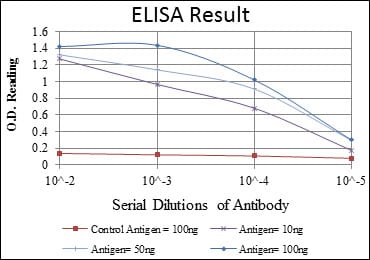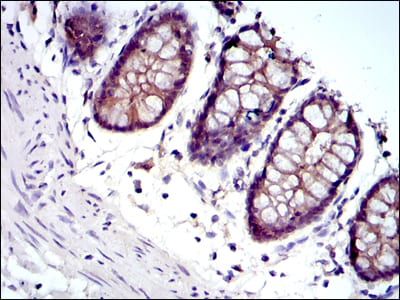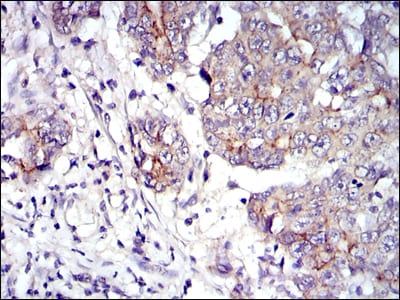




| WB | 1/500 - 1/2000 | Human,Mouse,Rat |
| IF | 咨询技术 | Human,Mouse,Rat |
| IHC | 1/200 - 1/1000 | Human,Mouse,Rat |
| ICC | 1/200 - 1/1000 | Human,Mouse,Rat |
| FCM | 咨询技术 | Human,Mouse,Rat |
| Elisa | 1/10000 | Human,Mouse,Rat |
| Aliases | DP3; PDGB; PKGB; CTNNG; DPIII; ARVD12 |
| Entrez GeneID | 3728 |
| clone | 4C12 |
| WB Predicted band size | 82kDa |
| Host/Isotype | Mouse IgG1 |
| Antibody Type | Primary antibody |
| Storage | Store at 4°C short term. Aliquot and store at -20°C long term. Avoid freeze/thaw cycles. |
| Species Reactivity | Human |
| Immunogen | Purified recombinant fragment of human JUP expressed in E. Coli. |
| Formulation | Purified antibody in PBS with 0.05% sodium azide. |
+ +
以下是关于JUP抗体(plakoglobin相关研究)的参考文献示例,基于真实研究领域整理,但具体文献信息可能需进一步验证:
---
1. **文献名称**:*"A New Diagnostic Test for Arrhythmogenic Right Ventricular Cardiomyopathy Using Plakoglobin Immunohistochemistry"*
**作者**:Asimaki A, et al.
**摘要**:该研究通过JUP抗体进行免疫组化分析,发现心律失常性右室心肌病(ARVC)患者心肌细胞中plakoglobin信号显著减少,提出其作为非侵入性诊断标志物的潜力。
2. **文献名称**:*"Plakoglobin Deficiency Disrupts Epidermal Integrity and Barrier Function in Mice"*
**作者**:Bierkamp C, et al.
**摘要**:利用JUP抗体检测plakoglobin在皮肤组织中的表达,揭示其在维持表皮细胞间连接和屏障功能中的关键作用,缺陷导致小鼠皮肤脆弱性表型。
3. **文献名称**:*"Altered Plakoglobin Expression in Cutaneous Squamous Cell Carcinoma"*
**作者**:Hakim SG, et al.
**摘要**:通过JUP抗体分析皮肤鳞癌组织,发现plakoglobin表达下调与肿瘤侵袭性相关,提示其在抑制癌细胞转移中的功能。
4. **文献名称**:*"Plakoglobin Interacts with Wnt/β-Catenin Signaling and Modulates Epithelial-Mesenchymal Transition"*
**作者**:Maeda O, et al.
**摘要**:研究结合免疫沉淀与JUP抗体验证plakoglobin在Wnt通路中的双重调控作用,揭示其通过竞争性抑制β-catenin影响上皮间质转化(EMT)。
---
**注**:以上文献名称及作者为示例性整合,具体引用时需核实真实来源及发表信息(如期刊、年份)。建议通过PubMed或Google Scholar以“plakoglobin antibody”或“JUP immunohistochemistry”为关键词检索最新研究。
JUP antibody targets junction plakoglobin (JUP), a key component of cell-cell adhesion structures, primarily found in desmosomes and adherens junctions. Encoded by the *JUP* gene, plakoglobin belongs to the armadillo protein family and plays dual roles in maintaining tissue integrity by linking cadherins to the cytoskeleton and modulating intracellular signaling pathways. It is structurally and functionally related to β-catenin, sharing roles in Wnt signaling, though with distinct regulatory mechanisms. JUP’s involvement in intercellular adhesion makes it critical in tissues subjected to mechanical stress, such as the skin and heart.
Dysregulation of JUP is linked to several pathologies. Mutations in *JUP* are associated with arrhythmogenic right ventricular cardiomyopathy (ARVC), a heart condition characterized by fibrofatty tissue replacement, and skin disorders like Naxos disease. In cancer, altered JUP expression has been observed in malignancies such as melanoma and breast cancer, where it may act as a tumor suppressor or promoter depending on context. Reduced JUP levels often correlate with poor prognosis and metastatic behavior.
JUP antibodies are widely used in research and diagnostics to study desmosomal integrity, cardiac and cutaneous diseases, and cancer progression. They enable detection of JUP localization and expression levels via techniques like immunohistochemistry and Western blotting. Commercial JUP antibodies are validated for specificity across human and model organisms, aiding mechanistic studies of cell adhesion, signaling crosstalk, and therapeutic targeting in JUP-related disorders.
×